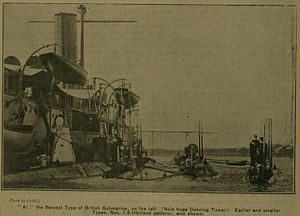HMS A1

HMS A1
|
|
| History | |
|---|---|
| Name: | HMS A1 |
| Builder: | Vickers, Barrow-in-Furness |
| Laid down: | 19 February 1902 |
| Launched: | 9 July 1902 |
| Fate: | Lost, 1911. Wreck rediscovered 1989. |
| General characteristics | |
| Class and type: | A-class submarine |
| Type: | Submarine |
| Displacement: |
|
| Length: | 103.25 ft (31.47 m) |
| Beam: | 11.9 ft (3.6 m) |
| Installed power: |
|
| Propulsion: |
|
| Speed: |
|
| Range: |
|
| Complement: | 11 (2 officers and 9 ratings) |
| Armament: | 2 × 18 in (460 mm) torpedo tubes (bow, four torpedoes) |
HMS A1 was the Royal Navy's first British-designed submarine, and their first to suffer fatal casualties.
She was the lead ship of the first British A-class submarines (a second, much different A-class appeared towards the end of the Second World War), and the only one to have a single bow torpedo tube. She was actually sunk twice: first in 1904 when she became the first submarine casualty, with the loss of all hands; however, she was recovered, but sank again in 1911, this time when she was unmanned. The wreck was discovered in 1989 and is now a protected wreck.
She was an enlarged and improved Holland class submarine - 40 ft (12 m) longer than the Royal Navy's five "Holland"-type boats. The most notable improvement was the addition of a conning tower. Subsequent A class boats were even larger and differed from her in several respects.
Like all members of her class, she was built at Vickers, Barrow-in-Furness. She was launched on 9 July 1902.
Before she left the yard she suffered from a hydrogen explosion. Later while under tow to Portsmouth to join with the rest of the navy's submarines seawater managed to reach her batteries which gave off chlorine gas forcing the evacuation of the vessel.
She was accidentally sunk in the Solent on 18 March 1904 whilst carrying out a practice attack on Juno by being struck on the starboard side of the conning tower by a mail steamer, SS Berwick Castle which was en route from Southampton to Hamburg. She sank in only 39 ft (12 m) of water, but the boat flooded and the entire crew was drowned. One consequence was that all subsequent Royal Navy submarines were equipped with a watertight hatch at the bottom of the conning tower.
...
Wikipedia
